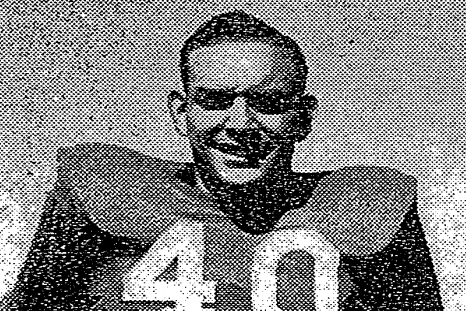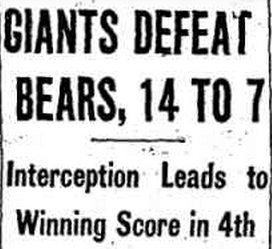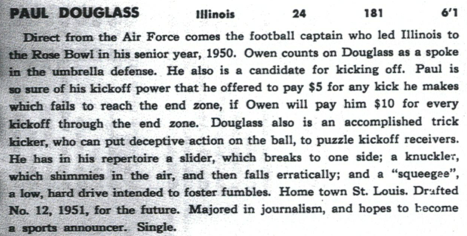It’s pretty well established who the first soccer-style kicker was in pro football: Pete Gogolak with the AFL’s Bills in 1964. You can look it up. In Week 1 that year against the Chiefs, he made all six of his boots – two field goals, four extra points – in a 34-17 Buffalo win.
After that, the deluge. Soccer-stylers started descending on the pro game from all directions . . . and all hemispheres. If you didn’t have one kicking for you by the end of the ’70s, you were swimming against a tsunami-sized tide.
I didn’t realize until just the other day, though, that another sidewinder — as they were called — had auditioned in the NFL 11 years earlier. His name was Paul Douglass, and he went to training camp with the Giants, who’d taken him in the 13th round of the 1951 draft. Is Douglass the first soccer-style kicker to don an NFL uniform, even if it was only in the preseason? As far as I know, yes. And trust me, I’ve done a lot of digging.
Douglass had been a standout at Illinois as a defensive back and occasional kickoff man. The latter skill, according to the school newspaper, was the byproduct of being of “being one of the better soccer players from the St. Louis area.” After graduating from college, he spent two years in the Air Force during the Korean War — growing to 6-foot-2, 188 pounds — before giving the pro game a shot.
In preparation for camp, Douglass, who didn’t play football in the service, worked hard to get his leg back in shape. Or as the Daily Illini put it:
Almost any late afternoon if you drive past Fairground Park down St. Louis way you’ll see a lone figure standing among a group of small boys.
Closer inspection will reveal it to be Paul Douglass, former University of Illinois star, who will join the New York Giants professional football team next month. The kids [are] just fans who serve as his retrievers when Paul is practicing kickoffs. . . .
The Giants signed Douglass . . . chiefly to help bolster their depleted defensive ranks, but Paul hopes to solidify his position with his kicking ability.
That was the thing about the NFL in 1953. With only 33 roster spots up for grabs, versatility was a necessity for most players. The more you could do, the better your chances of making the squad. Plenty of guys, after all, were still playing both ways — including Giants legend Frank Gifford. (Or as the team’s media guide called him, “Francis.”) Gifford scored five different ways that season (2 rushing touchdowns, 4 receiving TDs, 1 interception-return TD, 1 field goal, 2 extra points) and threw a touchdown pass.
Douglass struck an unusual deal with the Giants. “Besides his [regular pay],” the Daily Illini said, he “will get $10 for every kick that goes out of the end zone, $5 for every one that goes in the end zone, and he has to pay the Giants $5 for every kick that doesn’t go that far.” It might have been the first time a player promised a club a rebate if he didn’t reach a particular performance goal.
Both The New York Times and Brooklyn Eagle ran a United Press story about Douglass and his unconventional style. Besides being able to boom the ball, he had an assortment of trick kicks that were hard for a returner to catch. “I don’t kick the ball with my toe,” he was quoted as saying. “I slice the ball with the side of my shoe.”
His repertoire, the Giants’ media guide said, included “a slider, which breaks to one side; a knuckler, which shimmies in the air and then falls erratically; and a ‘squeegee,’” which sounds like a squib kick. He learned the last one “from an English soccer star,” the wire service reported. It was a low-liner of a boot that “will bounce in at least three different directions before it loses action on a muddy field.”
There’s no telling how many times Douglass kicked off in the 1953 preseason. Game stories simply weren’t that detailed. But we know he kicked off at least once — against the Baltimore Colts in a game played in his hometown of St. Louis. The Baltimore Sun described it thusly: “Douglass’ kickoff to start the game sailed over the Colts’ end zone.” That’s 70 yards in the air, folks — if not more.
But again, there was no way he was going to make the club just as a kicker. Kicking specialists were rare in those days, and kickoff specialists were unheard of. No, he had to be one Giants’ best defensive backs to survive the final cut. And truth be known, he did have his moments as a DB.
The biggest came in the fourth quarter against the Bears, when he picked off a George Blanda pass to set up the winning score in a 14-7 victory. The ball “rolled off Jim Dooley’s fingertips and into [Douglass’] arms,” the Chicago Tribune’s George Strickler wrote, “and the rookie from Illinois raced 46 yards up the field before he was overhauled by [Hall of Famer George] Connor.”
In the end, Owen decided to cut Douglass and let Gifford and second-year man Randy Clay share the kicking. The season turned out to be a 3-9 disaster for the Giants, one that cost Stout Steve his job after 23 years of meritorious service.
And so Douglass’ contribution to pro football history has been lost, buried beneath the clouds of dust generated by the Giants offense that season. (They averaged a feeble 2.6 yards per rushing attempt, by far the fewest in the league.)
Unless, of course, the NFL had a soccer-styler even further back. Rest assured I’ll keep looking. As impactful as kickers are nowadays, we’ve gotta make sure we have this Famous First nailed down.
Source: pro-football-reference.com
Related content: Remembering Garo Yepremian.



